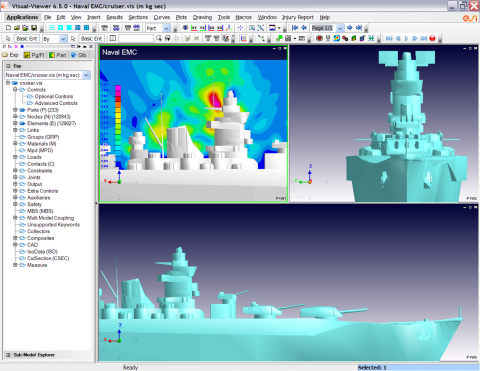ESI releases the new version of PAM-CEM Simulation Suite
ESI Group, pioneer and world- leading solution provider in virtual prototyping for manufacturing industries, announces the release of its latest version of PAM-CEM Simulation Suite. Dedicated to all engineers involved in the safe electromagnetic design of products, subsystems and systems, the PAM-CEM software package offers unique coupling capabilities, allowing multi-scale electromagnetic phenomena assessment in the middle and high frequency ranges. A major benefit for PAM-CEM end users is the ability to handle detailed 3D models of systems featuring emitting or receiving antennas and sophisticated cable networks.

Electromagnetic radiation of a naval antenna (Visual Environment)
This latest version of PAM-CEM provides several key enhancements, including treatment of 3D anisotropic materials and extended DMP (Distributed Memory Processing) parallel processing for improved performance. Most importantly it includes two major features:
The first breakthrough of this release is the completely new version of the PAM-CEM/HF software tool. This relies on physical optics, and addresses specialized applications in aeronautic RADAR as well as antenna radiations aboard very large sized naval ships. Based on more sophisticated techniques (analytical formulations & Gauss quadrature), this year’s upgrade allows handling of much larger elements having an overall size exceeding several wavelengths. This improvement leads to less RAM memory and allows for much faster computations. The latest version of PAM-CEM also displays an extended list of output results, including: near and far radiated fields; induced currents on the structure; regular 2D/3D radiation patterns; and, monostatic RCS values (RADAR Cross Section) with all four terms of the polarization matrix in one single run.
The second major new improvement lies in the 3D/3D coupling process now part of PAM-CEM/FD (Finite Difference Time Domain), which enables flexible management of sophisticated radiating devices. Once characterized in an accurate manner with local mesh refinement, a source can be easily moved or rotated inside much larger computational 3D domains without any particular meshing constraint.
In the field of Automotive RADAR and Active Safety devices, capabilities addressing computation of electromagnetic fields radiated in the so-called “near zone” area are being continuously improved. With the PAM-CEM Simulation Suite, rear blind spot detection, change lane assistance and Advanced Driver Assistance Systems (ADAS) can be investigated in a very realistic manner, taking into account the full 3D scene with the roadway, rail guards, obstacles and other reflecting vehicles. Simulations include the detail of the bumper structure nearby the emitting/receiving RADAR devices and account even for very thin paint coatings.
For usability, this new version of the PAM-CEM Simulation Suite is accompanied by the release of Visual-CEM 7.5, a dedicated pre- and post- processing environment focused on the advanced management of Cable Networks and providing many dedicated features for the specification of cables, connectors, CRIPTE tubes, harnesses and networks.
For more information on the PAM-CEM Simulation Suite, please visit our website: www.esi-group.com/electromagnetics